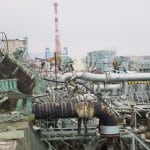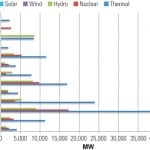By Kennedy Maize
Washington, D.C., March 14, 2011, 10:05 a.m. – Only France has been more resolute about relying on nuclear power than Japan. The reasons for both countries’ nuclear energy policies are generally the same: neither possesses much in the way of domestic energy resources. So nuclear power – including breeder reactors and a plutonium-uranium fuel cycle – is understandable.
The Federation of Electric Companies of Japan on its website says:
“Energy is the ‘life blood’ of any economy, but for Japan, this truism takes on added importance. Just a few simple facts should help to make it clear that Japan is poor in natural resources, specifically sources of energy, which are so vital to a healthy, modern economy:
*Japan must import over 80% of all primary energy needs
*Japan obtains only 0.3% of its crude oil supply from domestic sources
*Japan has very few domestic sources of coal, natural gas, or uranium.”
Japan features a complicating factor not present in France. Japan is very seismically active. The islands are part of a chain – the “ring of fire” – that describes an arc from New Zealand across Japan, reaching north to Russia’s Kamchatka Peninsula and east to Alaska’s Aleutian Islands. Japan sits where the Eurasian and Pacific tectonic plants crash together, producing earthquakes and volcanoes in profusion. This fact has complicated Japan’s nuclear ambitions from the start.
Japan’s romancing of the atom began in 1954 – the same year the U.S. adopted its second major piece of atomic energy legislation, the Atomic Energy Act of 1954, supplanting the 1946 law passed after World War II (and the U.S. dropping of two atom bombs on Japan). The new U.S. law aimed at refocusing U.S. efforts toward peaceful uses of the atom, although it largely failed in this goal for the next 10 years. Japan allocated funds to nuclear power R&D in 1954. The next year, Japan’s Atomic Energy Basic Law went into effect, limiting the nation’s pursuit of fission power to peaceful purposes only but putting the country on the path to serious nuclear power development.
In part because of early limits on export of U.S. atomic energy technology, Japan initially turned to Great Britain for help with civilian nuclear power. Japan’s first reactor was Tokai 1, a British-designed Magnox reactor (CO2 cooled and graphite moderated, using natural, un-enriched uranium as fuel). It was rated at 166 MW. Construction began in early 1961 and was completed in late 1965. The unit operated at the Tokai station until March 1998. Magnox nuclear technology proved a dead end, both in Britain and Japan. The Japanese soon shifted their attention to U.S.-designed light water reactors, both boiling water designs and pressurized water reactors. Fukushima Daiichi 1, for example, was a General Electric boiling water reactor. Construction started in 1967 and the plant went into commercial service in late 1970.
While Japan continued to procure nuclear steam supply systems from U.S. vendors, the country also began developing its own design and manufacturing technology. According to a paper published by the World Nuclear Association and updated in February, “By the end of the 1970s the Japanese industry had largely established its own domestic nuclear power production capacity….” According to the WNA, the first indigenous Japanese plants had performance problems, with capacity factors averaging below 50%. The country embarked on a program to improve nuclear performance and brought the plants up to world standards by the mid-1980s.
Japan, prior to the March earthquake and tsunami, had 54 operating reactor units with total capacity of slightly over 46 GW, providing about a third of Japan’s electricity. Two additional reactors are under construction, with design capacity of another 2,800 MW. Japan has also embarked on an ambitious, and troubled, breeder reactor program and a plan for reactors to burn mixed uranium-plutonium oxide fuel in thermal plants. Japan started up the 280-MW Monju prototype fast breeder reactor in 1994, but sodium coolant leaks and a subsequent fire shut the plant down in December 1995. There was an official cover up of the accident and widespread public outrage that kept the plant out of service for some 15 years. It restarted last May. Whether it was affected by the events of this month is not clear.
In September 1999, workers at the Tokaimura fuel facility were readying 18.8% enriched fuel for an experimental breeder when they allowed so much uranium in a mixing vessel that the material reached critical mass, exposing the workers to radioactivity and causing a local evacuation. Two of the three workers handling the material when it went critical later died of radiation poisoning. The International Atomic Energy Agency attributed the accident to “human error and serious breaches of safety principles.”
Japan’s conventional nuclear program has had its share of problems, including earthquake-related outages. In 2002, Japan’s regulators forced Tokyo Electric Power Co. to shut down all 17 of its reactors after company officials were charged with falsifying safety documents. They resumed service in 2005. A 2004 pipe break in the turbine building for one of the PWRs at the Mihama plant killed five workers and injured six others. In 2005, a 1970-vintage BWR at the Onagawa station shut down after an earthquake, following indications by plant seismic monitors that the plant had experienced shocks beyond its design basis. Later evaluation found no reactor damage, but the plant was shut down for five months. A July 2007 earthquake led to an extended outage at the Kasiwazaki-Kariwa plant, which caused considerable damage to non-safety related equipment, but not to critical elements of the plant.
None of Japan’s past nuclear power problems even approach the magnitude of what has happened in the aftermath of last week’s earthquake and subsequent tsunami.
For those inclined to do their own background research, here are some links, in no particular order:
Sandia National Laboratory pdf on BWR containments (everything you might want to know about BWR containments)
http://www.nrc.gov/reading-rm/doc-collections/nuregs/contract/cr6906/cr6906.pdf
U.S. Nuclear Regulatory Commission
Federation of Electric Power Companies of Japan
http://www.japannuclear.com/about/about.html
World Nuclear News, a publication of the World Nuclear Association
http://www.world-nuclear-news.org/RS_Battle_to_stabilise_earthquake_reactors_1203111.html
International Atomic Energy Agency, Facebook page, providing updates
http://www.facebook.com/note.php?note_id=201587349871059
Nuclear Energy Institute
Union of Concerned Scientists
Nuclear Information of Resource Service
Tokyo Electric Power Co.
http://www.tepco.co.jp/en/index-e.html








